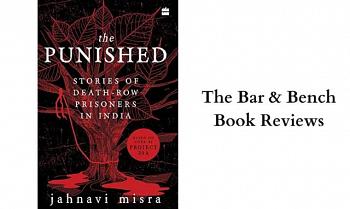The B&B Book Reviews: "The Punished" by Jahnavi Misra
The celebrated author and journalist Malcolm Gladwell, in his book Talking to Strangers, explores the various mistakes humans make while interacting with one another.
He suggests that humans, generally, are quite inept at understanding strangers. Yet, based on a single interaction, we are quick to draw assumptions about a stranger’s character and feel confident that we know her. In Gladwell’s book, people are at least afforded the luxury of an interaction before drawing an inference, no matter how grossly misplaced, about a person.
However, while thinking of a criminal, or worse, a death-row convict, people do not wait for an interaction to know the kind of person the convict would be. Every conceivable negative trait is attributed to the criminal, often, even before she is convicted.
This generalisation stems from an improper understanding of criminals as those people who are dissociated from the society, rather than being a part and product of it. To offer a different perspective into the lives and minds of the people demonised by society and rejected by the State, comes a deeply moving and thought provoking collection of stories of death row prisoners in India — The Punished.
The Punished, written by Jahnavi Misra, is based on interviews conducted by Project 39A, a criminal justice research centre at National Law University, Delhi. Between the period of 2013-16, Project 39A interviewed over 400 death row prisoners and their families to study their interaction with the criminal justice system.
Jahnavi Misra, a London based author, breathed life into this academic venture and transformed these stories into a profoundly moving book for the public.
The Punished introduces us to many lives: an ex-bandit, who turns to her notebook and pen to ward of the prison’s silence; a delirious letter written by an army officer, who has descended into madness after waiting for twenty five years as a death-row convict; the tribulations of an accused who can not understand a single word being said in court as all proceedings are in English; the agony of a street vendor, who throughout the course of a torturous beating by the police, can only think of the unattended goods at his cart; the ostracisation of an old toy maker in prison whose face was defiled by a vicious acid attack and so on.
Each story in the book is preceded by an image touching upon the theme of either the nature of the crime, or of the prisoner’s mental conflict. For instance, the story of a household aid being convicted for allegedly burning his employer’s house and thereby killing the entire family, shows the image of an empty well surrounded by violent flames.
And, the story of a father murdering his little daughters, features the image of a forlorn tree with a broken noose tied around a branch.
These images unsettle, shock, confuse, and disturb the reader, yet, succeed in creating a vivid image of the crime in the reader’s imagination. The evocative use of images and a magnificently descriptive writing forces the reader to think deeply about the concerned issues.
Together, these stories offer profound insights on the experiences of death-row prisoners, criminology, and the death penalty itself.
The author, however, cautions the reader about the fact that these stories are not direct transcriptions of the prisoners’ experiences. Despite the comprehensive data collected by Project 39A, Jahnavi Misra writes, only a limited amount is known about the inner lives of the convicts.
However, while the enumerated narratives have been subjected to a certain degree of authorial imagination (based on news reports and other contemporaneous sources), the stories still provide an important perspective on the prisoners’ carceral experiences.
Jahnavi Misra writes that the aim of the book is not merely to condemn the society for making wrong assumptions about death-row prisoners, but to urge people to realise that “justice can prevail only when criminals cease to be viewed as existing in vacuums, entirely separate from the everyday life of a society.”
Furthermore, the book does not strive to generate sympathy for the prisoners, nor does it undermine the severity of the prisoners’ offence. It simply attempts to help the reader look beyond the polarised media reporting of crime, and to see convicts as people with lives outside the crimes they committed and to tell their stories from, “before and after the moment of the critical act.”
The book contextualises crime and convicts through powerful stories and acquaints the reader with experiences alien to our worldview. It is a timely reminder of the fact that death-row convicts, despite the haunting nature of their crime, are human beings.
These stories, without swaying the reader towards a particular direction, help us see the commonalities between criminals and other people. As Jahanvi Misra writes, “the least we can do is get to know the ones we punish a little bit better.”
All in all, The Punished is an essential read for all students of law, members of civil society, and policy makers. Long after you have read the book, you find yourself twisting and turning in bed — disconnect and distraught — and questioning your erstwhile beliefs on the nature and implications of the death penalty. The Punished will cast a spell on you so strong, that it might take weeks, if not months, for you to break out of the trance.
As Dr. Anup Surendranath wrote in his foreword to The Punished, “the stories in this volume are written with the hope of making readers understand the people we want to kill. It is as much about the lives of prisoners and their families as it is about holding a mirror to society. Ultimately, it is an appeal to the humanity in all of us to know a little more about the people whose lives we want to take.”




